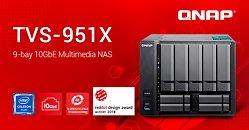Thursday, July 12th 2018

QNAP Completes its 9-bay NAS Lineup With the Award-Winning TVS-951X 10GBASE-T Multimedia NAS
Following the releases of the TS-932X (powered by an AnnapurnaLabs CPU) and the TS-963X (powered by an AMD CPU), QNAP Systems, Inc. today completes the high-capacity-compact-size 9-bay NAS lineup with the introduction of the TVS-951X 10GbE multimedia NAS. The new model is powered by a 7th-generation Intel Kaby Lake processor, providing a NAS private cloud solution that combines high capacity and 10GbE high-speed connectivity. The TVS-951X NAS has also won the Red Dot Award (2018) and Computex d&i Award for high-quality product design.Powered by a 7th-generation Kaby Lake 14nm Intel Celeron 3865U low-power dual-core 1.8 GHz processor, the TVS-951X features a hybrid drive bay design (including five 3.5-inch drive bays and four 2.5-inch SSD slots) with built-in 10GBASE-T (10G/5G/2.5G/1G/100M) network port. Combining hard drives and SSDs allow users to maximize both capacity and performance with SSD caching and Qtier auto-tiering storage. Combined with 10GbE connectivity, multimedia transcoding/streaming, and 4K HDMI output, the TVS-951X provides users with a cost-effective, highly-efficient, and high-performance NAS solution with feature-rich multimedia applications.
Key specifications
Availability
The new TVS-951X is now available.
"The TVS-951X provides the high potential storage capacity of a 9-bay NAS within the frame of a standard 5-bay NAS. With a hybrid storage structure that allows the joint benefits of hard drives and SSDs to be fully maximized, the TVS-951X excels in providing small/medium businesses with a dependable and scalable storage solution."Featuring advanced Intel HD Graphics 610, the TVS-951X supports dual-channel 4K H.264/H.265 hardware decoding and real-time transcoding. Users can directly enjoy videos up to 4K@30FPS on a TV using the HDMI output, or they can stream their media files to multiple devices using QNAP's Cinema28 multi-zone multimedia application, Plex Media Server, or Roon Server.
Jason Hsu, Product Manager of QNAP.
Key specifications
- TVS-951X-8G: 8GB DDR4 RAM (2 x 4 GB), upgradable to 32GB
- TVS-951X-2G: 2GB DDR4 RAM (1 x 2 GB), upgradable to 32GB
Availability
The new TVS-951X is now available.

7 Comments on QNAP Completes its 9-bay NAS Lineup With the Award-Winning TVS-951X 10GBASE-T Multimedia NAS
The only real advantage to these overpriced systems is they are ready to go upon purchase and very compact. The low-power and compactness has its cost in upgradability restriction though.
I think their biggest consumers are SMBs, freelancers and consultants which is a pretty big market.
It is nice you can buy them and throw up some immense storage in 15 minutes. I speculate that they are so expensive just because the vendors can get away with it. Kind of like how businesses spends tens of thousands in buying servers when they could saves many thousands if they bought Supermicro and built the servers themselves.
The primary metric for simply buying NAS vs building is time and in-house expertise of specing and building. I've been in numerous positions where the IT director wanted a hands on approach and am now at one where the director just wants to buy and be done with it.
I've always loved to build and maintain.